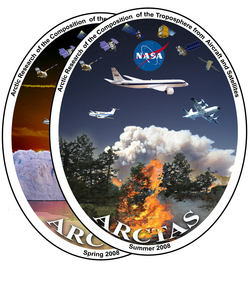Arctic Research of the Composition of the Troposphere from Aircraft & Satellites

Disciplines: Field Campaigns
| Collection | Disciplines | Spatial | Temporal |
|---|---|---|---|
|
ARCTAS_Model_Data_1
ARCTAS Model Data |
Aerosols, Clouds, Tropospheric Composition |
Spatial Coverage: (S: 32, N: 90), (W: -180, E: 180) |
Temporal Coverage: 2008-03-30 - 2008-07-14 |
|
ARCTAS_Trajectory_Data_1
ARCTAS Kinematic Trajectories |
Field Campaigns |
Spatial Coverage: (S: 7.5, N: 90), (W: -180, E: 180) |
Temporal Coverage: 2008-03-30 - 2008-07-14 |
| Collection | Disciplines | Spatial | Temporal |
|---|---|---|---|
|
ARCTAS_Merge_DC8-Aircraft_Data_1
ARCTAS DC-8 Aircraft Merge Data |
Aerosols |
Spatial Coverage: (S: 32, N: 90), (W: -180, E: 180) |
Temporal Coverage: 2008-03-30 - 2008-07-15 |
|
ARCTAS_Merge_P3B-Aircraft_Data_1
ARCTAS P-3B Aircraft Merge Data |
Aerosols, Clouds, Radiation Budget, Tropospheric Composition |
Spatial Coverage: (S: 32, N: 90), (W: -167, E: -60) |
Temporal Coverage: 2008-03-31 - 2008-07-13 |
| Collection | Disciplines | Spatial | Temporal |
|---|---|---|---|
|
ARCTAS_Aerosol_AircraftInSitu_DC8_Data_1
ARCTAS DC-8 Aircraft In-situ Aerosol Data |
Aerosols |
Spatial Coverage: (S: 32, N: 64.76), (W: -169.5, E: -179.8933) |
Temporal Coverage: 2008-03-16 - 2008-07-15 |
|
ARCTAS_Aerosol_AircraftInSitu_P3B_Data_1
ARCTAS P-3B Aircraft Aerosol In-situ Data |
Aerosols, Clouds |
Spatial Coverage: (S: 32, N: 81), (W: -164, E: -68) |
Temporal Coverage: 2008-03-25 - 2008-07-13 |
|
ARCTAS_AerosolTraceGas_AircraftInSitu_DC8_Data_1
ARCTAS DC-8 Aircraft In-situ Aerosol Trace Gas Data |
Field Campaigns |
Spatial Coverage: (S: 32, N: 90), (W: -180, E: 180) |
Temporal Coverage: 2008-03-18 - 2008-07-14 |
|
ARCTAS_AircraftRemoteSensing_BE200_HSRL_Data_1
ARCTAS BE-200 Aircraft HSRL Data |
Aerosols |
Spatial Coverage: (S: 36.5, N: 76), (W: -168, E: -76.5) |
Temporal Coverage: 2008-03-30 - 2008-07-14 |
|
ARCTAS_AircraftRemoteSensing_DC8_DIAL_Data_1
ARCTAS Differential Absorption Lidar (DIAL) Remotely Sensed Data |
Aerosols, Tropospheric Composition |
Spatial Coverage: (S: 32, N: 90), (W: -180, E: 180) |
Temporal Coverage: 2008-03-31 - 2008-07-15 |
|
ARCTAS_AircraftRemoteSensing_P3B_AATS14_Data_1
ARCTAS P-3B Aircraft AATS14 Data |
Aerosols, Tropospheric Composition |
Spatial Coverage: (S: 32, N: 81), (W: -164, E: -68) |
Temporal Coverage: 2008-03-25 - 2008-07-13 |
|
ARCTAS_AircraftRemoteSensing_P3B_CAR_Data_1
ARCTAS P-3B Aircraft CAR Data |
Clouds, Radiation Budget |
Spatial Coverage: (S: 32, N: 81), (W: -164, E: -46.5) |
Temporal Coverage: 2008-03-25 - 2008-07-13 |
|
ARCTAS_Cloud_AircraftInSitu_DC8_Data_1
ARCTAS DC-8 Aircraft In-situ Cloud Data |
Clouds |
Spatial Coverage: (S: 32, N: 90), (W: -180, E: 180) |
Temporal Coverage: 2008-03-16 - 2008-07-15 |
|
ARCTAS_Ground_Data_1
ARCTAS Ground Site Data |
Field Campaigns |
Spatial Coverage: (S: 32, N: 86), (W: -169.5, E: -36.5) |
Temporal Coverage: 2008-03-05 - 2008-05-01 |
|
ARCTAS_JValue_AircraftInSitu_DC8_Data_1
ARCTAS DC-8 Aircraft In-situ Photolysis Rate Data |
Field Campaigns |
Spatial Coverage: (S: 32, N: 90), (W: -180, E: 180) |
Temporal Coverage: 2008-03-17 - 2008-07-14 |
|
ARCTAS_MetNav_AircraftInSitu_DC8_Data_1
ARCTAS DC-8 Aircraft In-situ Meteorological and Navigational Data |
Field Campaigns |
Spatial Coverage: (S: 32, N: 90), (W: -180, E: 180) |
Temporal Coverage: 2008-03-16 - 2008-07-15 |
|
ARCTAS_MetNav_AircraftInSitu_P3B_Data_1
ARCTAS P-3B Aircraft In-situ Meteorological and Navigational Data |
Field Campaigns |
Spatial Coverage: (S: 32, N: 81), (W: -164, E: -68) |
Temporal Coverage: 2008-03-23 - 2008-07-14 |
|
ARCTAS_Ozonesondes_Data_1
ARCTAS Ozonesondes Data |
Field Campaigns |
Spatial Coverage: (S: 39.5, N: 80.5), (W: -157, E: 158) |
Temporal Coverage: 2008-04-01 - 2008-07-13 |
|
ARCTAS_Radiation_AircraftInSitu_P3B_Data_1
ARCTAS P-3B Aircraft Radiation In-situ Data |
Radiation Budget |
Spatial Coverage: (S: 32, N: 81), (W: -164, E: -68) |
Temporal Coverage: 2008-03-29 - 2008-07-12 |
|
ARCTAS_Satellite_Data_1
ARCTAS Supplementary Satellite Data Products |
Tropospheric Composition |
Spatial Coverage: (S: -90, N: 90), (W: -180, E: 180) |
Temporal Coverage: 2008-03-01 - 2008-07-31 |
|
ARCTAS_TraceGas_AircraftInSitu_DC8_Data_1
ARCTAS DC-8 Aircraft In-situ Trace Gas Data |
Field Campaigns |
Spatial Coverage: (S: 32, N: 90), (W: -180, E: 180) |
Temporal Coverage: 2008-03-18 - 2008-07-14 |
|
ARCTAS_TraceGas_AircraftInSitu_P3B_Data_1
ARCTAS P-3B Aircraft In-situ Trace Gas Data |
Field Campaigns |
Spatial Coverage: (S: 32, N: 81), (W: -164, E: -68) |
Temporal Coverage: 2008-03-23 - 2008-07-14 |
ARCTAS Mission Publications
Nair, Arshad Arjunan; Yu, Fangqun; Campuzano‐Jost, Pedro; DeMott, Paul J.; Levin, Ezra J. T.; Jimenez, Jose L.; Peischl, Jeff; Pollack, Ilana B.; Fredrickson, Carley D.; Beyersdorf, Andreas J.; Nault, Benjamin A.; Park, Minsu; Yum, Seong Soo; Palm, Brett B.; Xu, Lu; Bourgeois, Ilann; Anderson, Bruce E.; Nenes, Athanasios; Ziemba, Luke D.; Moore, Richard H.; Lee, Taehyoung; Park, Taehyun; Thompson, Chelsea R.; Flocke, Frank; Huey, Lewis Gregory; Kim, Michelle J.; Peng, Qiaoyun (2021). Machine Learning Uncovers Aerosol Size Information From Chemistry and Meteorology to Quantify Potential Cloud‐Forming Particles.
Nault, Benjamin A.; Campuzano-Jost, Pedro; Day, Douglas A.; Guo, Hongyu; Jo, Duseong S.; Handschy, Anne V.; Pagonis, Demetrios; Schroder, Jason C.; Schueneman, Melinda K.; Cubison, Michael J.; Dibb, Jack E.; Hodzic, Alma; Hu, Weiwei; Palm, Brett B.; Jimenez, Jose L. (2021). Interferences with aerosol acidity quantification due to gas-phase ammonia uptake onto acidic sulfate filter samples.
Pai, Sidhant J.; Heald, Colette L.; Pierce, Jeffrey R.; Farina, Salvatore C.; Marais, Eloise A.; Jimenez, Jose L.; Campuzano-Jost, Pedro; Nault, Benjamin A.; Middlebrook, Ann M.; Coe, Hugh; Shilling, John E.; Bahreini, Roya; Dingle, Justin H.; Vu, Kennedy (2021). An evaluation of global organic aerosol schemes using airborne observations.